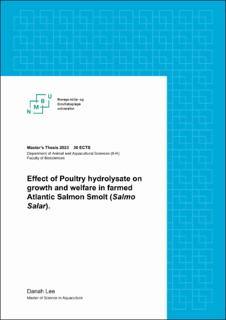| dc.contributor.advisor | Turid Mørkøre | |
| dc.contributor.author | Lee, Danah Hui Yang | |
| dc.date.accessioned | 2023-05-19T16:27:15Z | |
| dc.date.available | 2023-05-19T16:27:15Z | |
| dc.date.issued | 2023 | |
| dc.identifier | no.nmbu:wiseflow:6753177:53015891 | |
| dc.identifier.uri | https://hdl.handle.net/11250/3068361 | |
| dc.description.abstract | The objective of this study was to investigate the effects of different levels of poultry hydrolysate (PH) on the performance and welfare of 94g per Atlantic salmon smolts. Five experimental diets were fed to the fish for 43 days in triplicate 300L tanks, containing 0%(Control), 5%(C5), 10%(C10), 15%(C15), and 20%(C20) of poultry hydrolysate. Growth rate, feed conversion ratio, visceral fat analysis, liver, heart and faeces, whole body composition and welfare operational indicators and blood samples were examined. Results showed that the inclusion of PH 5% and 10% significantly improved growth rate and feed conversion ratio compared to the control group. Blood serum analyses revealed no adverse effects, and no mortality or cataract were observed. The control group had significantly higher score for deformity, although the level was low. Severity of scale loss was higher for the C20 group compared with the control. Scores for fin damage in active and healed phase were low, although active dorsal fin damage was highest for the C5 group, while healed pectoral fin damage was highest for the C10 group. Accumulation of fat around the viscera was lower of the C10 and C20 groups, lower fat deposits were observed on the heart surface of the C5, C10 and C15 groups compared with the control. Analyses of whole-body composition revealed decreasing dry matter content with increasing inclusion of PH. The fat content was higher in fish fed 5% PH, whereas the fat content was lowest for the fish fed 15% PH compared with the control. The ash content of the PH groups did not differ from the control group, but the condition factor was higher for the C15 group compared with the control. The slaughter yield was significantly lower for all groups fed PH (0.5-0.8% units), while inclusion of 5% PH significantly improved the faeces texture. These findings show that dietary inclusion of CH affects growth, lipid deposition pattern, fish welfare and consistency of faeces, suggesting that the inclusion of poultry hydrolysate at 5-10% in the diet for Atlantic salmon smolts can enhance production efficiency without compromising their welfare. | |
| dc.description.abstract | The objective of this study was to investigate the effects of different levels of poultry hydrolysate (PH) on the performance and welfare of 94g per Atlantic salmon smolts. Five experimental diets were fed to the fish for 43 days in triplicate 300L tanks, containing 0%(Control), 5%(C5), 10%(C10), 15%(C15), and 20%(C20) of poultry hydrolysate. Growth rate, feed conversion ratio, visceral fat analysis, liver, heart and faeces, whole body composition and welfare operational indicators and blood samples were examined. Results showed that the inclusion of PH 5% and 10% significantly improved growth rate and feed conversion ratio compared to the control group. Blood serum analyses revealed no adverse effects, and no mortality or cataract were observed. The control group had significantly higher score for deformity, although the level was low. Severity of scale loss was higher for the C20 group compared with the control. Scores for fin damage in active and healed phase were low, although active dorsal fin damage was highest for the C5 group, while healed pectoral fin damage was highest for the C10 group. Accumulation of fat around the viscera was lower of the C10 and C20 groups, lower fat deposits were observed on the heart surface of the C5, C10 and C15 groups compared with the control. Analyses of whole-body composition revealed decreasing dry matter content with increasing inclusion of PH. The fat content was higher in fish fed 5% PH, whereas the fat content was lowest for the fish fed 15% PH compared with the control. The ash content of the PH groups did not differ from the control group, but the condition factor was higher for the C15 group compared with the control. The slaughter yield was significantly lower for all groups fed PH (0.5-0.8% units), while inclusion of 5% PH significantly improved the faeces texture. These findings show that dietary inclusion of CH affects growth, lipid deposition pattern, fish welfare and consistency of faeces, suggesting that the inclusion of poultry hydrolysate at 5-10% in the diet for Atlantic salmon smolts can enhance production efficiency without compromising their welfare. | |
| dc.language | eng | |
| dc.publisher | Norwegian University of Life Sciences | |
| dc.title | Effect of Poultry hydrolysate on growth and welfare in farmed Atlantic Salmon Smolt (Salmo Salar). | |
| dc.type | Master thesis | |


